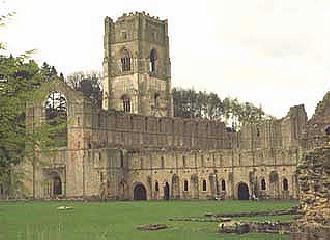 |
 |

Fountains Abbey
[Wednesday - 10/26/94] Fountains Abbey has accurately been described as the 'crown and glory of all that monasticism has left us in England'. 800 years of history are there to be explored in the huge estate. The ruins of the Cistercian Abbey, founded in 1132 by 13 monks, are the largest of such remains in Europe. They provide a dramatic focal point for the landscape garden laid out during the first half of the 18th century by John Aislabie.
We immediately lost ourselves in the criss-crossing paths that wind past elegant ponds, cascades, follies and classical temples by centuries-old trees. Other features within the estate are St. Mary's Church (a masterpiece of Victorian Gothic design) and Fountains Hall, Elizabethan mansion built partly with stone from the Abbey. Fountains Abbey was acquired by the National Trust in 1983 and declared a World Heritage Site in 1987.
Unquestionably one of the most evocative of all the ruined abbeys we visited, this Cistercian institution dates back to 1132 when a small group of intellectual monks broke away from the Benedictine abbey of St. Mary’s in York to follow a stricter rule. After three years’ of hardship, the small community at Fountains were joined by the ex-Dean of York (Hugh) who provided the means to commence building the largest, and most celebrated, monastery of the time. Despite its grand scale, the original construction would have been in the austere and simple form commonly associated with Cistercian views.
However, a continual re-building program, spanning some 400 years, saw much enhancement to the severity of the plain stonework and many elaborate structures incorporated into the basic monastic complex. Every architectural period and building style are represented in some part of Fountains Abbey and this diversity, coupled with the sheer enormity of this site, give us such an important understanding of monastic life prior to the Dissolution in 1539.
Due to its remote location in the valley of the River Skell, the ruins are both impressive and extensive. The abbey church survives to almost full height, including the tower built c.1500, above the north transept, which rises to an awesome 170 ft. A very distinctive and unusual feature of Fountains Abbey church is the additional transept built at the eastern end of the presbytery. This splendid, and once lavishly decorated extension is paralleled with only one other in England, and that is to be found at Durham Cathedral.
|
Last modified on Wednesday, November 26, 2008 URL: http://www.housecorvus.org/fou.htm Copyright © 2000-09 House Corvus. All rights reserved. Design and hosting by Bran Trefonnen. | |